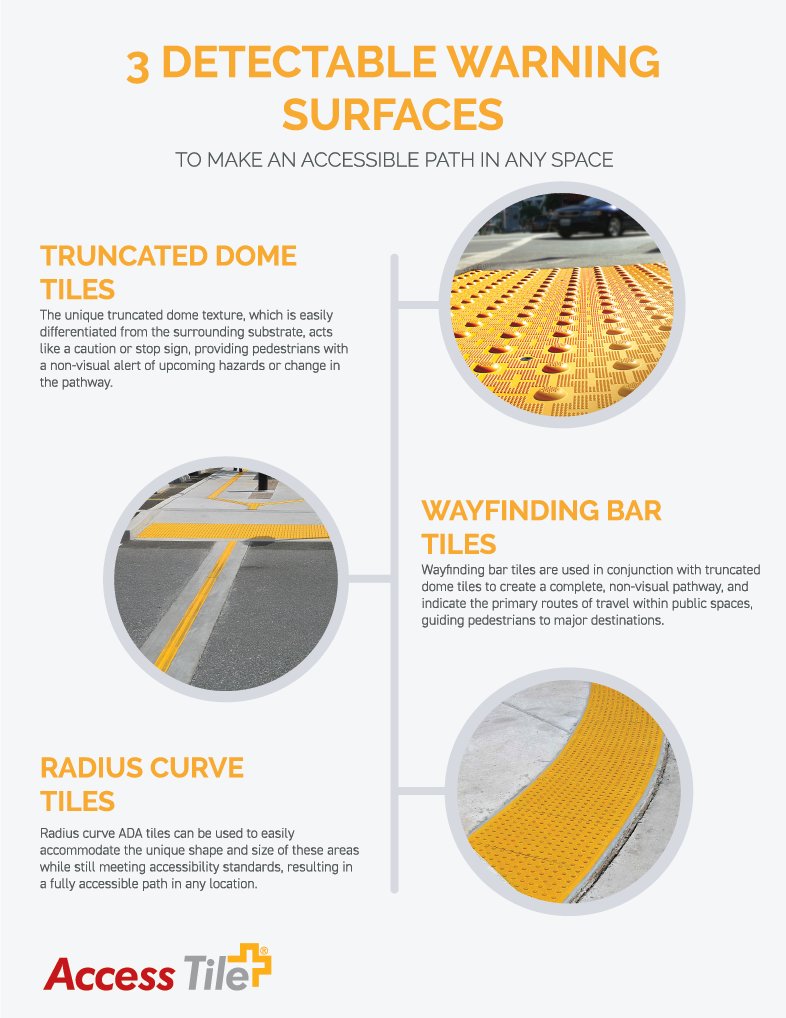As a major aspect of the Americans with Disabilities Act (ADA) detectable warning surfaces are used to ensure public spaces can easily be accessed by persons of all abilities, by providing non-visual wayfinding ques.
The intended purpose of ADA tiles is to protect visually impaired pedestrians from potential hazards, such as sudden drops, unexpected objects, or oncoming traffic, as well as creating safe and easy to follow pathways.

Truncated Dome Tiles
As the most popular detectable warning surface, truncated dome tiles can be seen installed in a number of public spaces including transit stations, parking lots, pedestrian pathways, and more. The unique truncated dome texture, which is easily differentiated from the surrounding substrate, acts like a caution or stop sign, providing pedestrians with a non-visual alert of upcoming hazards or change in the pathway.
Simply, a detectable warning surface with truncated domes is used to mark a decision-marking point along a pathway or communicate the end of the path. Truncated dome tiles are a vital aspect of creating an accessible path in any public space.
Wayfinding Bar Tiles
Rather than a repeating dome texture, wayfinding ADA tiles are comprised of a series of raised bars, with a micro-texture on and in-between each bar for enhanced detectability and slip-resistance. Where truncated dome ADA tiles are used to call attention a pedestrian’s surroundings and act as a sign of caution, wayfinding tiles are used to provide orientation and navigation to persons with visual impairments.
Wayfinding bar tiles are used in conjunction with truncated dome tiles to create a complete, non-visual pathway, and indicate the primary routes of travel within public spaces, guiding pedestrians to major destinations such as transit stops, information desks, and elevator call buttons. Wayfinding ADA tiles allow person with visual impairments to orient themselves in an unfamiliar space and follow their desired path safely and without barriers.
Radius Curve Tiles
One of the most common application locations of ADA tiles is on curb ramps, or at pedestrian crossings. The subtle slope of a curb ramp was introduced to allow persons using wheelchairs or other mobility aids to easily mount and dismount the sidewalk. This however, removed the tactile clue of the change in pathway, which was provided by the drop-off of the curb. To counteract this, ADA tiles have become required on all curb ramps.
Radius curve ADA tiles can be used to easily accommodate the unique shape and size of these areas while still meeting accessibility standards, resulting in a fully accessible path in any location.
By installing ADA tiles, you can create an easy to follow, code-compliant pathway, allowing your space to become truly accessible!
Access® Tile offers the ultimate solution in detectable warning surfaces, provides a full range of ADA tiles to ensure a code compliant solution for every project! Our expertly engineered detectable warning pavers are available as replaceable cast in place tiles, which are the ideal solution for new projects, as well as surface applied tiles which can be used to easily retrofit existing surfaces. Additionally, Access® Tile offers directional wayfinding tiles and a range of radius tile sizes, perfect for pedestrian crossings.
Rely on Access® Tile to create accessible pathways in any space!












